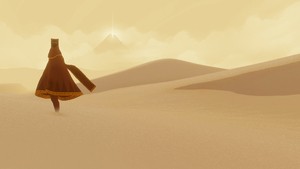
The long-awaited release date of thatgamecompany's Journey was finally announced recently. Before the follow up to flower trots onto PlayStation Network next month — 13th March for North America, 14th March for Europe and 15th March for Japan — Push Square spoke to Jenova Chen, co-founder and creative director of thatgamecompany, about some of the inspirations and decisions behind the developer's latest emotional outburst.
Push Square: Your latest game is Journey. Please could you briefly sum up what it’s all about?
Jenova Chen: When we make games at thatgamecompany, our philosophy is to try to bring a new and fresh experience that the player has never had in the past. When we worked on Journey, this is our third PlayStation Network game, so we wanted to try to make a game about multiplayer, particularly about making the player have an emotional connection with another player. And this is something that I rarely see in a console video game, because most of them are about, y’know, killing each other, or killing something together. The player rarely has a bond with another player. And so when we worked on Journey, that was the focus — how can we create a world, and a type of gameplay, that people will actually like each other? (laughs) Have a feeling that they are actually companions.
We call it an interactive parable, an anonymous online adventure, that is exploring life’s passages, and how they cross with each others, with other peoples’ life passage. It’s very much like hiking. A lot of people go to hike and they wanna go to the peak of the summit, the top of the mountain. On the way you might actually run into other journeyers who are also heading to the mountain. If you like each other you can stay together and travel as a group. If you don’t like each other, you pass over each other and you continue to travel alone. Sometimes the team might break up, you might lose track of each other, but later you will run into each other again. It’s very much how life is. We run into all kinds of people. We might depart at some point, we might reunite. It may sound pretentious, but if you actually play the game, if you actually experience it, it is very, very different.
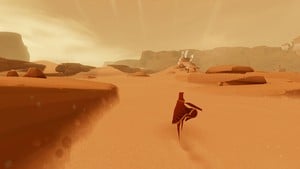
PS: The art style’s very distinct. Was there any particular inspiration for that? Maybe a particular parable, since you note Journey as an interactive parable?
JC: (laughs) We didn’t choose our art direction based on a parable, but definitely the art director — Matt Nava — had a desire to create an art style that is timeless. A lot of the classic games if you look back, some of the games really show their age. But some of the games still look beautiful and stand out, y’know, like [The Legend of Zelda:] The Wind Waker. He wanted to create an art style that would not really be tied to the current status quo of graphics. Stay away from the realism. At the studio we call it impressionistic realism.
For example, with flower we made people feel real by using the simulation and interaction, but exaggerated it a little bit. It’s beyond real, but actually when you play, it feels real. In Journey it’s very much about the quality of the sand: how the sand sparkles in the different light situations, how players can leave trails and how they can surf in the sand. The simulation and shader technology are very supportive to the art style. The art style actually went through a couple of iterations. We went from very extremely realistic to a very oil-painted look, to a cartoon look, and then eventually to the final Journey look.
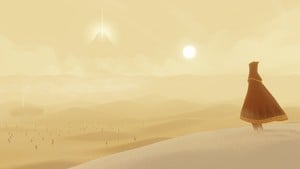
PS: In previous games you’ve had an evolving character in flOw, the wind and petals in flower, but this time there’s an actual character there. What was behind that decision?
JC: There’re many reasons. Technologically, when we first started flOw and flower, we just didn’t have character animators. We couldn’t do characters, we only had two engineers. When we moved on to Journey, finally we could do it, but you can tell that we’re still not doing it very well. Our character doesn’t have hands, arms, feet, because to do those things you need to write collision awareness systems, so the character would know how to put his feet aligned to the ground — a lot of very difficult tasks that would typically come in Unreal game engine for free. We don’t really use Unreal. I think the best design often comes from a constraint. Do we really want to spend a guy working on his feet for a whole year so that the character looks like he’s standing on the slope? We said, “well, that’s not really what the game’s about, so let’s change the design.”
The reason the character doesn’t have arms is that in most online games, if the character has arms people say “oh, why can’t he pick up a weapon?” (laughs) We don’t want the player killing something with a weapon. We say, “well, he doesn’t have arms, so don’t think about it.” (laughs) Early on our game character did have arms, so when he actually jumped over a platform and almost landed on it but he missed it, people would always say “why couldn’t his arm just grab on the platform, like Drake, or Prince of Persia?” We’d say “well, we don’t really have anyone to work on this.” So we removed the arms. Then nobody... (laughed)
We don’t want the player killing something with a weapon. We say, “well, he doesn’t have arms, so don’t think about it.”
PS: So nobody asked the question any more?
JC: Yes! So under all these constraints we felt like we had to change the character design. No mouth, no arms, no feet.
PS: I think that actually works quite well without the feet though, with the pin legs instead, because from what I’ve played, a lot of it you’re gliding around, sliding down sand dunes, and it feels like there’s an element of play. I think that lack of feet and the simplicity of the character actually works very well with that.
JC: Yeah, it’s definitely a happy coincidence of many constraints, yeah. (laughs) We like the character as well.
PS: Obviously there’s a lot of sand, a lot of open space. This is quite a big step up from flower.
JC: Actually, in terms of real estate, the sheer volume of the world, Journey is about 2.25 times bigger. The level is twice wider, twice longer, than flower, and there are more levels. So yeah, [there] is more space, but I think it’s also because our team is slightly larger. For flower we had seven to nine people, versus Journey [where] we had nine to twelve people.
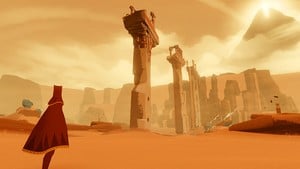
PS: You’re journeying around, but there are also goals and concrete targets in there, aren’t there? When I played there was a puzzle with some pillars.
JC: There are some environmental puzzles, but it’s not really the focus of the game. The game’s goal is simple: go to the mountain. The level you played is more of an early level that is kind of trying to teach the player about how to navigate, and also what is the relationship between the player and the cloth [to help movement]. Once that’s taught... In the later levels I don’t think there’s anything like that any more. Each level is very distinct. They are very much about different things. Wait and see!
PS: How did you keep those worlds interesting with such open space?
JC: It is a lot of things we learned from theme park design, that we learned from Disney, from Disneyland’s design. When you have open space it often feels like you don’t know where to go, you feel lost. You don’t know how to navigate. Actually in Journey we can say it’s huge but the experience is rather guided, because there’s always a ‘doorway’, a giant ‘weenie’ — which is a Disney term, it’s something in the distance to guide you in the right direction. If you were to wander really far away from the map, we do have an invisible wall that tells you, “hey, that’s probably not the direction you wanna go.” So we’ve tested the game on at least 200 people and they all managed to find their way out themselves, so we’re pretty proud of that. We used the environment to guide the player without using words, or compass, or map.
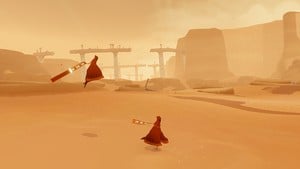
PS: Despite the co-operative focus, there’s no voice chat. I heard that you originally had it in, so can you explain the process you went through with that?
JC: As soon as we put one player into the game, it is very, very immersive. It has that magical quality of taking you into a new space, out of reality. But when we see the other player, initially our instinct is “let’s display what his name is”. The problem is, immediately you know, “oh I’m playing with this guy in a company, I’m playing with the Sony QA people.” It takes you out of the world right away. You can imagine if you’re meeting someone online, his name is like... (laughs) Let’s say BeachBoy1982. Immediately you know this guy’s attitude, you know how old he is.
When you know the identity of the other player, it often distracts you from the world. You know his age, you know he’s a guy, you know all this information, which is not really necessary for a character who does not have a face, or a mouth, or arms. You don’t really need to know if this character is male or female. Once you take out the name you of course don’t want them to talk, because if you hear the voice you will be distracted. With text you’d be distracted. You have to do it all the way to the extreme to treat the game purely.
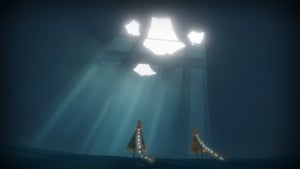
PS: Moving off Journey, how do you approach the creative process for a new game?
JC: At thatgamecompany the focus is always based on emotion, because we see entertainment as a food for emotion. When you’re sad you want to listen to happy music to cheer you up, or watch a comedy movie, or read a very delightful book. If you look at music or movies, they have a wider variety of genre. Each genre is kind of tied to a particular feeling. When you look at the emotional spectrum of video games, I think it has a lot of equivalents to the summer blockbuster action adventure film. It has a lot of horror films. It has a lot of sports. But it doesn’t necessarily have a lot of drama; the emotional width and depth that video games manage to accomplish is still very limited. That’s why we started thatgamecompany, we wanted to spearhead [that in] the video game industry and explore the emotional breadth; the width and the depth.
Flower is very much about a peaceful, harmonic experience that you rarely see in games. It’s more about the width. Journey is more about the depth. It’s thatgamecompany’s vision of an adventure game. It’s our vision of an online co-op game. We see it from an emotional level, we want people to feel like they’re really going out on an adventure. In order to go on an adventure, you can’t know too much about the adventure. You can’t just get a map, or just have people tell you, “your mission is go to this waypoint, do this thing.” That takes out the feeling of adventure. Adventure is about going to a place that is unknown.
In order to go on an adventure, you can’t know too much about the adventure. That takes out the feeling of adventure. Adventure is about going to a place that is unknown.
[In Journey] the online co-op experience is, the people really have to feel that they can rely on each other, rather than feel like a typical game where you’re all-powerful and you’re just killing things. Why would you want to work with another player? We wanted to give people a reason to like each other. Journey is very much about creating a feeling, a sense of wonder, which is essential for an adventure. The second thing is a sense of [being] small. The feeling [that] the character is very small, tiny. The character wouldn’t be thinking about how to hunt down a giant beast, or how to kill everything he sees; instead he should feel [that] he’s very much relying on the world and relying on other players. That’s kind of the experience we’re going for.
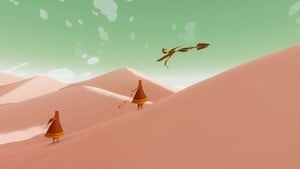
PS: He’s not the sole driving force behind the world, he is part of that world.
JC: Right. He is just a little leaf in the world.
PS: What’s next for thatgamecompany? Since it’s just come out, would you consider working with PS Vita?
JC: Thatgamecompany had a three game contract with Sony, so the past three games had to be Sony exclusive. Right now we are very much exploring ways to bring our games to a bigger audience, beyond just PlayStation. We are still in the process of negotiating, but I hope that we can announce it [soon]. But right now it’s still in the process.
PS: Finally, what do you feel are the essential elements to a journey? What makes it important?
JC: I think it’s learning. It’s learning about yourself. Self-reflection.
PS: Thank you for your time!


Comments 5
Fantastic interview Mike. I'm really looking forward to Journey.
I'm still worried that the game might seem a bit boring. This is easily the most interesting and best-looking game I've seen from them, but I'd need at least a long demo to see how much variety might be in the game.
Wow, nice read. Can't wait for this game
Been waiting for this game to come out since last March when I first got a PS3
Push Square spoke to Jenova
When is the Reunion?
This actually really sounds cool ... I haven't ever played any of their games though. Maybe I should look into getting them.
Show Comments
Leave A Comment
Hold on there, you need to login to post a comment...